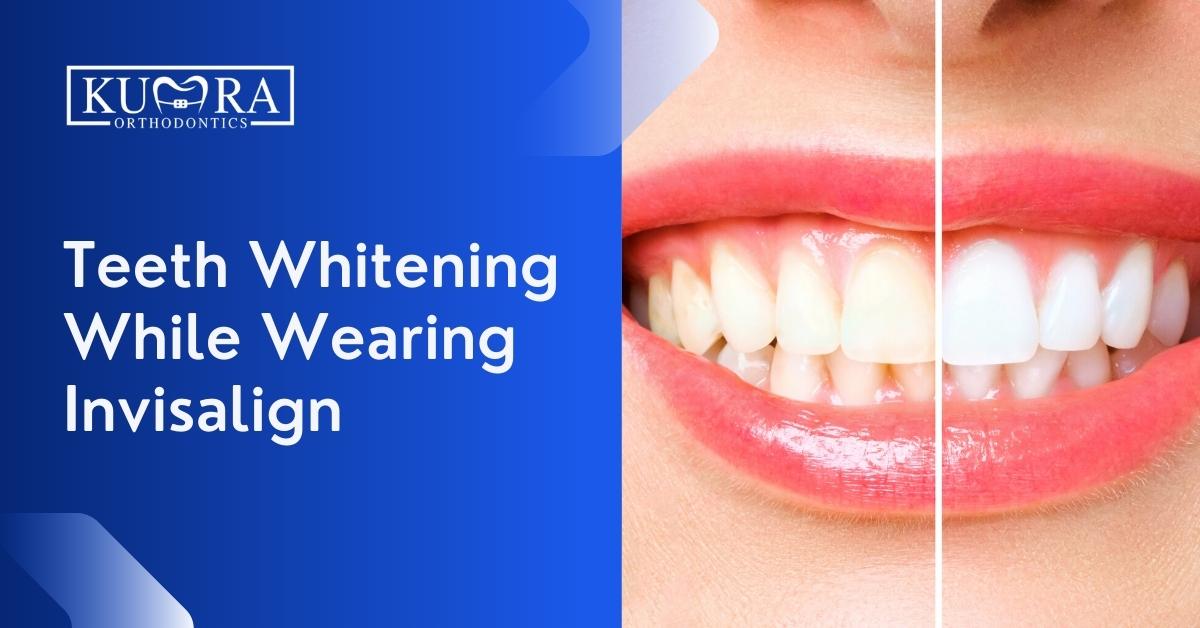Invisalign is a popular orthodontic treatment that many people choose because it is discreet and doesn’t require any metal wires or brackets. However, one question that often comes up is whether or not you can whiten your teeth while wearing Invisalign. The good news is that you can definitely whiten your teeth while wearing Invisalign, but there are a few things to keep in mind. Keep reading to learn more!
What Causes Teeth Stains?
Diet and Lifestyle
The main causes of teeth staining are diet and lifestyle. The foods and drinks we consume daily can cause our teeth to become stained and discolored over time. Common culprits include coffee, red wine, tea, berries, and dark-colored sodas.
Smoking and Bad Dental Hygiene
Tooth staining can also be caused by smoking and bad oral hygiene habits. Tobacco smoke contains tar and other cancer-causing chemicals that can discolor teeth over time. Moreover, if you don’t brush your teeth regularly or use dental floss, plaque will build up on your teeth and turn into tartar. This hard mineral deposit will yellow your teeth over time.
Medication Use
One lesser-known cause of teeth stains is from taking certain medications. Many medications contain coloring agents that can stain teeth over time. Some of the more common medications that can cause tooth staining include tetracycline antibiotics (such as doxycycline), antimalarial drugs (such as chloroquine and hydroxychloroquine), high blood pressure medications (such as captopril and enalapril), antihistamines (such as diphenhydramine), and seizure medications (such as phenobarbital).
Needing an orthodontic appointment?
Visit Kumra Orthodontics Washington, DC or Kumra Orthodontics Stafford, VA, and request an appointment with us!
How to Whiten Teeth While Wearing Invisalign at Home
Invisalign trays and teeth whitening trays are not the same. Because Invisalign trays fit more snugly than teeth whitening trays, the gel may leak into the mouth instead of remaining on the teeth.
Nevertheless, whitening solutions are designed particularly for aligners that employ foam rather than gel to whiten teeth during aligner therapy.
There are tooth-whitening products without trays, such as whitening toothpaste and mouthwashes. You can also utilize over-the-counter teeth whitening products when you are not obliged to wear your aligners.
Most orthodontists recommend beginning the treatment six months after the realignment. This is because tooth sensitivity increases with age. This can result in several interconnected problems. For example, discoloration appears in areas not subjected to whitening procedures. Therefore, the result is an uneven look.
In-chair Teeth Whitening
During in-office teeth whitening, a high bleach concentration is given to the teeth. The solution is then activated using ultraviolet radiation, commonly known as laser whitening.
The most secure way of teeth whitening is whitening under the supervision of a dentist. Using rubber and gauze seals, your gum line and lips are protected from the effects of bleach. In addition, the dentist will supervise your teeth whitening treatment.
Alternative whitening treatments, such as over-the-counter whitening kits, may be less successful since they utilize less bleach. In addition, trays that are not custom-fitted to the patient’s mouth might allow the bleach to seep onto the gum line. Bleach can produce chemical burns when left in contact with oral tissue for extended periods.
Take-home kits
Take-home whitening kits are another alternative for teeth whitening at home.
Take-home kits function similarly to in-office dental whitening procedures, except that the chemicals and solutions used are often weaker and less potent than those used by a dentist.
Whitening toothpaste and mouthwashes
Often, less intense forms of tooth whitening, such as the use of toothpaste or mouthwashes with whitening agents, can be helpful for those who wear aligners. Wearers have reported that the aligners help keep the whitening agents close to their teeth, providing greater whitening action. Such whitening agents can help break down surface stains, while tiny abrasive particles can scrub and polish the surface of the teeth.
Whitening Gel
If you like to whiten your teeth throughout your Invisalign treatment, please inform a member of our clinical staff, and we will provide you with a complimentary whitening gel. This gel is a low-intensity whitening agent that may be used in your Invisalign aligner while you sleep every night for one to two weeks.
You would apply a little drop of the gel in each compartment of the aligner, then position the aligner on your teeth and wipe away any extra gel from your mouth or gums. Leave the whitening gel on your teeth for at least 90 minutes; alternatively, you can sleep with the aligner in and rinse your mouth and aligner with lukewarm water later.
In conclusion, it is not only a good idea to use Invisalign to achieve straight teeth and a healthy bite, but it is an even better idea to whiten your teeth simultaneously. Always adhere to the directions of our clinical team and the advice of your family dentist or one of our expert doctors.
Whitening Options to Avoid
Lemon Juice or Apple Cider Vinegar
As a mouthwash, home treatments such as lemon juice or apple cider vinegar can erode the enamel of your teeth.
Activated Charcoal
Activated charcoal tooth scrubbing is something of a fad, but it is not without hazards. For example, abrasive charcoal can erode tooth enamel.
In both of the instances mentioned above, enamel wear will expose more dentin, and the yellow will eventually emerge. Before selecting a whitening procedure, it is usually preferable to consult your dentist since the cheapest solutions are not necessarily the best or safest. Prior to whitening, it is essential to get a comprehensive dental examination to ensure that your teeth are clear of plaque and tartar.
Swishing Oils or Spices Around in Your Mouth
The ancient Indian technique of oil pulling is said to remove toxins through the gums and mouth. Typically, coconut oil is chosen, swished about the mouth for a brief duration, and then expelled. In addition to the oil, spices such as turmeric are placed on the teeth to boost the natural whitening capabilities of the two substances.
However, solid scientific research has not yet demonstrated that oil pulling or turmeric is an especially effective whitener. Our cosmetic dentists propose incorporating these elements into home-cooked meals instead.
Frequently Asked Questions
Can you use a whitening gel with Invisalign trays?
While it is possible to use a whitening gel with Invisalign trays, it is not recommended. All-day bleaching will cause significant sensitivity in your teeth and burn your gums. If you are looking to achieve whiter teeth, we suggest using an at-home whitening kit or visiting your dentist for professional treatment.
Why are my teeth turning yellow with Invisalign?
Invisalign aligners do not cause your teeth to be yellow; this is a common misconception. The discoloration of the teeth often occurs because of the foods and beverages consumed while the aligners are in place. Some of the most common culprits include coffee, red wine, and tea. To minimize the likelihood of staining, it is important to avoid these beverages and brush your teeth regularly (preferably after every meal) with fluoride toothpaste.
Read more: Wearing Your Retainers After Not Wearing Them For Years
Consult with Kumra Orthodontics to learn more about whitening with Invisalign
Whitening your teeth while wearing Invisalign is a great way to achieve the perfect smile. However, it’s important to note that not all whitening methods are compatible with Invisalign aligners. If you’re looking to brighten your smile while wearing Invisalign, consult with an orthodontist in Washington, DC and Stafford VA like Dr. Kumra. We can help you find the best whitening method and ensure that your Invisalign treatment goes smoothly. Are you ready to get started on your journey to a brighter smile? Contact us today!



